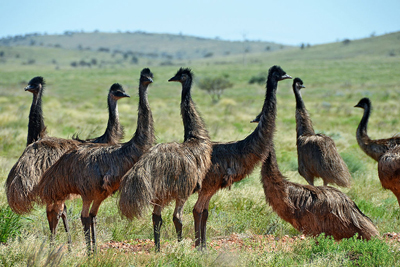
The Emu, the second tallest bird in the world, followed by the Ostrich, can reach up to 5 feet to 5feet 6 inches in height and is the fourth or fifth heaviest living bird after two species of ostrich and two larger species of cassowary, weighing around 45 kg. However, their females are usually slightly larger than males and are substantially wider across the rump. Although flightless, they can run at speeds of 48km/h (30mph) with their powerful legs, equipped with three forward-facing toes in each foot that allow them to grip the ground and thrust forward their bodies. While running, they flap their vestigial wings, measuring around 8 inches, probably as a means of maintaining balance or stabilizing themselves when moving fast.
Once common on the east coast of Australia, emus live in various habitats across Australia, both inland and near the coast. Their movement in Western Australia follows a distinct seasonal pattern, north in summer and south in winter. However, in the east coast, their wanderings seem to be more random and do not appear to follow a set pattern. They also live in savannah woodlands and prefer areas with access to standing water.

The long neck of the emu is pale blue and shows through its sparse feathers. They look shaggy for their grey-brown plumage, but that protects them from the solar radiation and helps them to beat the heat in their hot and arid habitats. Their long legs are devoid of feathers and their feet are equipped with cushioned pads. With their long legs, they usually take strides of about three feet when walking, but while they run, a stride can be as long as nine feet. They have sharp claws on their toes, which are their major defensive weapons, and are used in combat to inflict injuries on opponents by kicking. Their eyes are protected by transparent secondary eyelids, which protect the eyes from dust as visors. Equipped with good eyesight and hearing, they can detect threats at some distance. Although the emu females are usually slightly larger than males, they look alike, except when the penis of the male becomes visible at the time of his urination or defecation.

The emus spend their day feeding, preening their plumage with their beak, dust bathing, and begin to settle down at sunset and sleep during the night. However, they do not sleep continuously, but rouse themselves several times during the night. When they fall into a deeper sleep, their neck droops closer to the body, the beak turns down, and the whole neck becomes S-shaped, while the eyelids begin to close. Their diet includes Acacia, commonly known as wattles, Casuarina, slender evergreen shrubs and trees, and grasses, depending on seasonal availability. However, they also eat insects like grasshoppers, crickets, cockroaches, ladybirds, spiders, and the like. Strange it may seem, but sometimes they also swallow small stones to assist in the grinding up and digestion of the plant material. In captivity, they have been known to eat even charcoal, marbles, shards of glass,keys, and nuts. Emus drink infrequently, usually once a day, but ingest large quantities, depending on opportunities.

The vocalizations of emus mainly consist of various booming and grunting sounds and most of the booming is done by females as a part of the courtship ritual, announcing the holding of territory and threat to the possible rivals. Strangely, it is not the males, the female emus court the males as they stride around, pulling their neck back, while puffing out their feathers and emitting low monosyllabic calls. As she gains the attention of a male, she circles her prospective mating partner from a distance, looks at him by turning her neck, and at the same time keeping her rump facing towards him. The male, if becomes interested, stretches his neck, erects his feathers, sidles up to the female, swaying his body and neck from side to side, and rubbing his breast against his partner's rump. If she agrees, she signals acceptance by squatting down and raising her rump. During the courtship period, the female becomes more aggressive and often fights with other females for access to a mate. If any intruding female tries to court a male that already has a partner, the incumbent female will try to repel the competitor, usually by chasing and kicking.

During the breeding season, the summer months of December and January, emus form breeding pairs, when both the males and females put on weight, with the female becoming slightly heavier at between 45 and 58kg. However, during the breeding season, males experience hormonal changes, and their testicles become double in size. Mating usually takes place between April and June, and the males take the responsibility to construct a rough nest in a semi-sheltered hollow on the ground. Usually, the nest is made on open ground or near a shrub or rock, from where the emu has a clear view of its surroundings and can detect approaching predators.

The pair usually mates more than once every day, and every second or third day the female lays one of a clutch of five to fifteen very large, thick-shelled, green eggs. After that, while the male incubated the eggs continuously for about 56 days, without any food or drink, even without defecating, the female moves around, and sometimes mating with a different male. The chicks stay with their dad, grow very quickly, and become fully grown within five to six months.